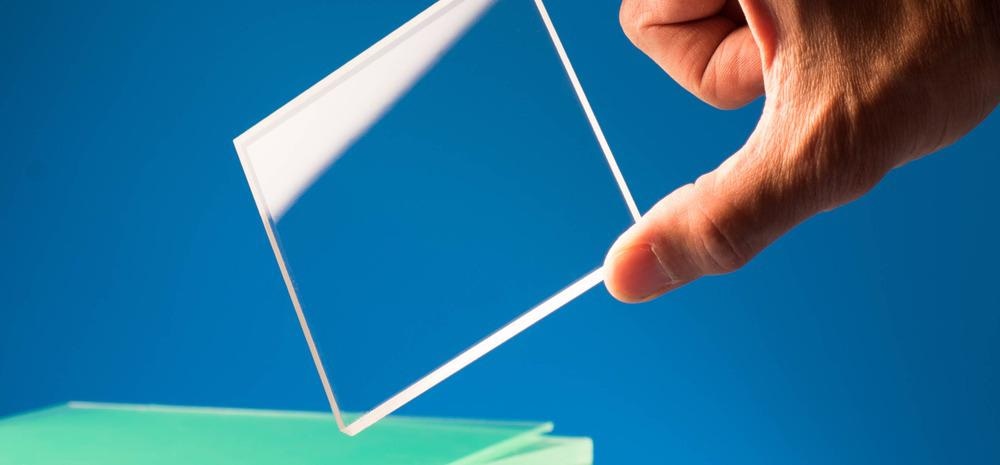Chalcogenide glass is widely used today in a number of specialist optics applications. Recent experiments with adding silver to the glass-forming materials that make chalcogenide glass have revealed that this technique can impart useful properties such as a low temperature of glass transition and increased hardness.

Image Credit: noprati somchit/Shutterstock.com
What is Chalcogenide Glass?
Chalcogenide glass is a type of glass that contains one or more elements known as chalcogens. The molecules in this type of glass have been covalently bonded together, and the material can be classified as a covalent network solid.
The chalcogen elements are in group 16 in the periodic table. They include sulfur (S), selenium (Se), and tellurium (Te). Chalcogens are combined with elements that form material networks like silicon (Si), arsenic (As), germanium (Ge), phosphorus (P), and antimony (Sb) to make chalcogenide glass.
Polonium (Po) is also a chalcogen. However, it is not commonly used for manufacturing chalcogenide glass due to its strong radioactivity, which makes it unsafe to handle.
Chalcogenide materials behave differently to oxides, mainly because of their lower band gaps. This contributes to different optical and electrical properties that make these materials highly sought after by modern electric and information technology manufacturers.
Classical chalcogenide glasses were usually sulfur-based, such as As-S (arsenic and sulfur) or Ge-S (germanium and sulfur).
All chalcogenide materials are strong glass formers. They make glasses within large concentration forming regions. The glass forming ability of chalcogenide materials decreases as the molar weight of its constituent elements increases. This means that sulfur-based chalcogenides are best for glass forming, followed by selenium, and then tellurium.
Chalcogenide glass compounds like AgInSbTe and GeSbTe are widely used today in the information technology sector. Rewritable optical disks and phase-change memory devices use the unique optical properties of this material to work effectively.
These applications rely on the unique thermal properties of chalcogenide glass. As the applied temperature changes, the materials switch between an amorphous (glassy) state and a crystalline state. This capacity for phase modification is used to rewrite memory, physically altering the structure of the material that stores the data.
Chalcogenide glasses also exhibit a high refractive index, low phonon energy, and high nonlinearity. All of these unique traits make the material ideally suited to optics applications.
What is Chalcogenide Glass Used For?
Chalcogenide glasses on integrated waveguide platforms at the telecommunications wavelength have been successfully employed in the advance of nonlinear all-optical signal processing. This technology has the potential to rapidly speed up data transfer and ultimately make the connected world work better.
So far, arsenic and sulfur- or selenium-based chalcogenides have seen the greatest use in these applications. As2S3 and As2Se3 have been widely employed in optics applications since specialized synthesizing methods were established.

Image Credit: luchschenF/Shutterstock.com
The difficulty of designing new methods to synthesize different types of chalcogenides is the main barrier to further study of this class of useful glass-forming materials. However, recent studies have begun to break this barrier down.
What is GeSbS Glass?
Infrared detectors, moldable infrared optics like lenses, and flexible optics like infrared optical fibers are all suitable applications for GeSbS chalcogenide glass. The main advantage in these applications, as mentioned above, is the materials’ capacity for transmitting across a wide range of the infrared electromagnetic spectrum.
The high refractive index, low phonon energy, and high nonlinearity of chalcogenide glasses like GeSbS also makes them well-suited for use in lasers, planar optics, photonic integrated circuits, and other active devices. They can also be doped with rare-earth element ions to further improve and refine these features.
Chalcogenide glass is made with germanium, antinomy, and sulfur molecules. Combining these materials makes a stable ternary glass product with a wide range of possible compositions.
GeSbS chalcogenide glass is known for its striking nonlinear optical properties. These glasses show only negligible nonlinear losses at around 1.5 microns (μm).
GeSbS glasses also display optical transparency from 12 μm and up to 25 μm. This is a relatively wide window of optical transparency that makes GeSbS glasses ideally suited for short-wave or medium-wave to long-wave infrared (IR) applications in optics (both linear and nonlinear).
Properties of GeSbS Glass Doped with Silver
Two recent studies have experimented with GeSbS glass doped with silver. The results of these studies show that silver can function as a doping agent with chalcogenide glass, and that useful properties are imparted to the glass when this is done.
The material hardness of the glass is increased drastically by up to 26% when silver is added. This is due to the silver filling up tiny cavities in the glass structure.
Another recent study found that glass that has been doped with silver has a lower temperature of glass transition. Glass transition is the temperature at which amorphous (glassy) regions switch between rigid and more flexible states. A lower temperature of glass transition means that a material is more flexible and pliant.
These studies together show that chalcogenide glass doped with silver is harder, but also viscous at a lower temperature. Flexible nonlinear optics applications can make use of these discoveries by exploring how silver doping can improve the technology.
References and Further Reading
Fraenkl, M. (2018). How silver influences the structure and physical properties of chalcogenide glass (GeS2)50(Sb2S3)50.” Journal of Non-Crystalline Solids. Available at: https://doi.org/10.1016/j.jnoncrysol.2018.07.046.
Musgraves, J.D., S.Danto, and K.Richardson (2014). “Thermal properties of chalcogenide glasses.” In Chalcogenide Glasses: Preparation, Properties and Applications. Woodhead Publishing. Available at: https://doi.org/10.1533/9780857093561.1.82.
Shrivastava, A. (2018). “Glass Transition and Melting Temperatures.” In Introduction to Plastics Engineering. William Andrew. Available at: https://doi.org/10.1016/C2014-0-03688-X.
Včeláková, M., P. Košťál, and P. Honcová (2021). “Effect of silver addition on thermal properties of (GeS2)50(Sb2S3)50 glass.” University of Pardubice. Available at: https://hdl.handle.net/10195/78450.
Won Choi, J. et al. (2016). “Nonlinear characterization of GeSbS chalcogenide glass waveguides.” Scientific Reports. Available at: https://doi.org/10.1038/srep39234.
Disclaimer: The views expressed here are those of the author expressed in their private capacity and do not necessarily represent the views of AZoM.com Limited T/A AZoNetwork the owner and operator of this website. This disclaimer forms part of the Terms and conditions of use of this website.